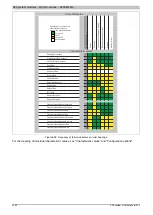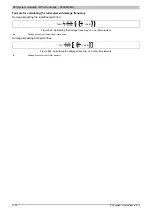
X20 system modules • Other functions • X20CM4810
X20 system User's Manual 3.10
2109
Two neighboring lines (samples) in the spectrum that are already outside the set window (one above and one
below the window) will be partially included in the calculation depending on their distance from the window.
Am
pl
itu
de
Frequency [Hz]
Partial inclusion in calculation
Figure 680: Partial inclusion of marginal lines in the calculation
Guidelines for configuring the frequency bands
•
The total range of the frequency band is at least 2 * 0.005 * max. drive frequency [Hz].
•
The upper and lower frequency limits must not be less than 0.005 * max. drive frequency [Hz] from the
desired average frequency.
Example
At a maximum drive frequency of 50 Hz, a frequency band should be set at 10 Hz.
10 Hz ± (0.005 * 50 Hz) = At least 9.75 Hz lower and 10.25 Hz upper frequency band limits
•
Depending on the MaxFrequency selected, a least three lines should be configured within each frequency
band.
•
The first lines to the left and right of the configured frequency band are included proportionally based on
their distance from the frequency band (see image above).
Broadband RMS
In this configuration, the RMS value of the configured signal and channel in the frequency band is calculated. The
value is calculated from the minimum frequency ("FrequencyBandXXLowerFrequency") to the maximum frequency
("FrequencyBandXXUpperFrequency"). The minimum and maximum frequency can be entered here in increments
of 0.25 Hz.
Any channel for any frequency band can be selected.
The following signals can be selected for each channel:
•
Raw acceleration signal
•
Raw velocity signal. Equal to 0 if the speed calculation is disabled.
•
Enveloped acceleration signal
•
Enveloped velocity signal. Equal to 0 if the speed calculation is disabled.
The harmonic frequencies (whole number multiples) of the window can also be included in the calculation. Here,
the width of the window is simply retained and the mean frequency of the window is multiplied (by 1, 2, 3, etc.) until
the maximum frequency of the configured signal and channel is reached.
Speed-dependent RMS
In this configuration, the RMS value is calculated in a movable window. There are 4 speed inputs for this ("Ac-
tSpeed01-04" in 0.01 Hz). One of the 4 speeds can be selected for each of the 32 frequency bands. In addition,
the standardized damage frequency at 60 rpm ("FrequencyBandXXDmgFreq60rpm") and a tolerance ("Frequen-
cyBandXXTolerance") must be configured. These can be configured separately for each frequency band.
The window in which the RMS is calculated is determined as follows:
Minimum frequency = (speed * standardized damage frequency at 60 rpm) – tolerance
Maximum frequency = (speed * standardized damage frequency at 60 rpm) + tolerance
The standardized damage frequency and tolerance can be entered here in increments of 0.01 Hz.






























